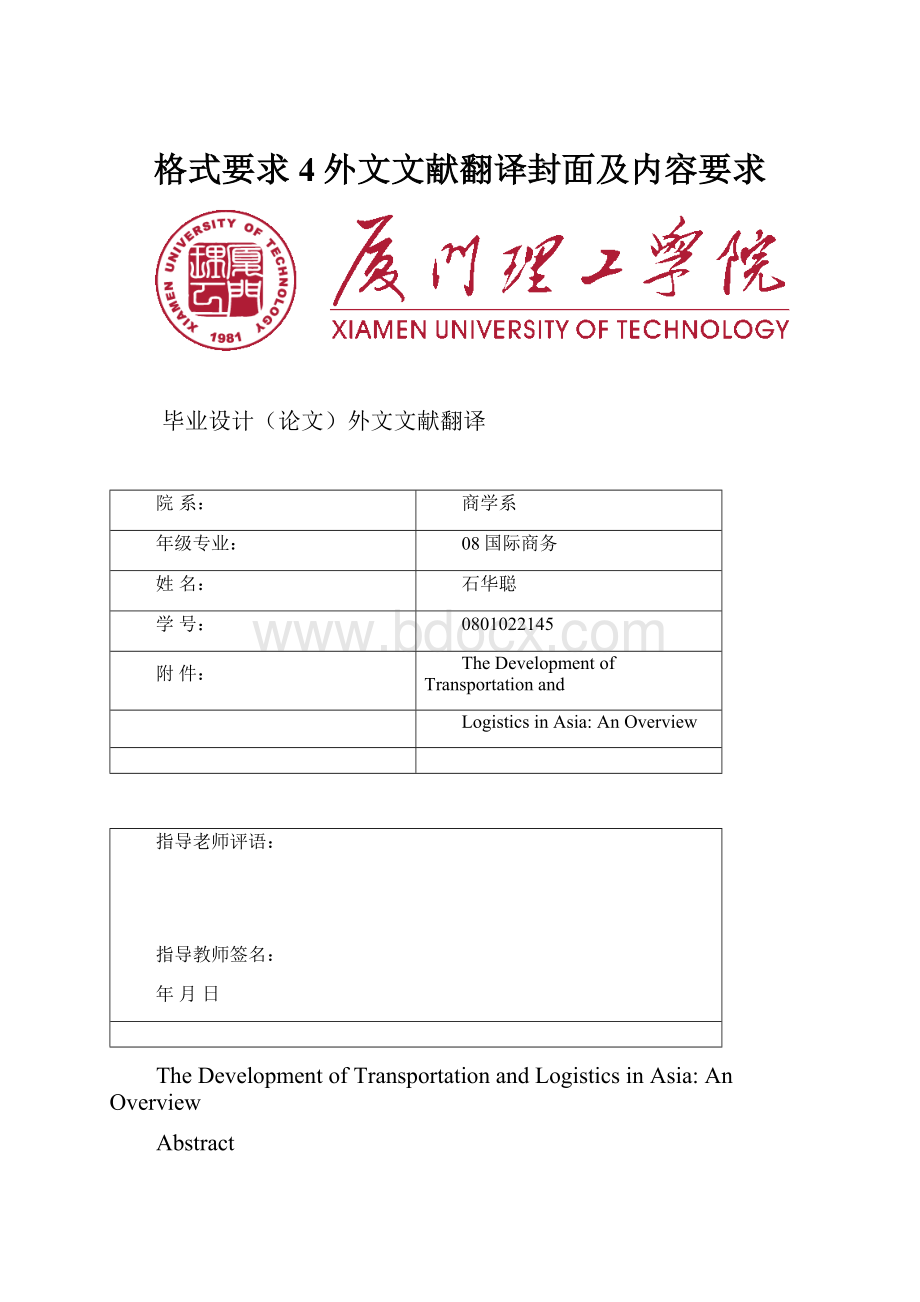 格式要求4外文文献翻译封面及内容要求.docx
格式要求4外文文献翻译封面及内容要求.docx
- 文档编号:22841302
- 上传时间:2023-04-28
- 格式:DOCX
- 页数:11
- 大小:110.60KB
格式要求4外文文献翻译封面及内容要求.docx
《格式要求4外文文献翻译封面及内容要求.docx》由会员分享,可在线阅读,更多相关《格式要求4外文文献翻译封面及内容要求.docx(11页珍藏版)》请在冰豆网上搜索。

格式要求4外文文献翻译封面及内容要求
毕业设计(论文)外文文献翻译
院系:
商学系
年级专业:
08国际商务
姓名:
石华聪
学号:
0801022145
附件:
TheDevelopmentofTransportationand
LogisticsinAsia:
AnOverview
指导老师评语:
指导教师签名:
年月日
TheDevelopmentofTransportationandLogisticsinAsia:
AnOverview
Abstract
Asia'stradehassoaredoverthepasttwodecades.AnintegratedandglobaldirectdistributionbusinessmodelhasalreadybeendevelopedtoshipproductsdirectlyfromAsiatoWesternandothermarketsalongtheglobalsupplychain.Inspiteoftheirrichresources,Asiancountrieshavenotbeenabletoutilizetheirvastpotentialduetothelackofregionalconnectivityandtotheexistenceof"chokepoints"inAsiansupplychains.AnAsia-widetransportandlogisticsnetworkisessentialforAsiancountriestogettheirgoodstomarketsmoreeffectively,butitsoverallprogresshassofarbeenlimited.Aninnovativeapproachisneededtoaddressthephysicalinfrastructureaswellasthenonphysical,softinfrastructureissues.ThisarticleconcludeswithsolutionsidentifiedbyAsia-PacificEconomicCooperation(APEC).Thefocusofthisarticleisonselectedareaswithin.
Overview
Withthefastpaceofglobalizationsincethe1980s,particularlytheoutsourcingofmanufacturingandservicesfromdevelopedWesterncountriestolow-costAsiandevelopingcountries,Asianeconomieshavebeengrowingrapidlyandhavebecometheworldfactoryoffinishedgoods.Asia'stradehassoaredoverthepasttwodecades,withthePeople'sRepublicofChina(PRC)inparticularrecordingexplosivegrowth.ThePRC'sexportsgrewatanaverageofmorethan18percentperyearbetween1990and2007,whiletheothereightemergingeconomiesamongAsia'stop-10exportersrecordedexportgrowthofmorethan10percentayear(BrooksandStone2010).Abusinessmodelthatisintegratedandglobal,usesdirectdistribution,andemphasizesshippinghigh-valueproductsfromAsianfactoriesdirectlytoworldwidemarketshasbeendevelopedbymultinationalfirms.Thisintegratedmodelreplacesthetraditionalmultiechelon,pushbasedintemationaldistributionmodel;italsohelpstoreduceredundantinventoriesalongtheglobalsupplychainandspeedsuptimetomarket(Su2007).Duetoallthesechanges,Asianowaccountsforaboutone-fourthofworldtradeandworldgrossdomesticproduct(GDP),respectively(WorldBank2006).
Withabout4.1billionpeoplein2009(PRB2009),Asiaisthemost
populousregionintheworld,accountingfor60percentofpopulation
andrepresentingenormousmarketopportunitiesformultinationalfirms.Therearearound20cross-regionalfreetradeagreements(FTAs)atdifferentstagesofimplementationthere.TheconsolidationofFTAsimproveseconomicwelfarecomparedtothecurrentbilateralism.AbroadPan-Asianagreement(coveringgoods,services,andtradecosts)involvingEastAsianandSouthAsianeconomiesisestimatedtooffersignificantimprovementtothegeneralwelfarethroughgainstoglobalincomeofaround$261billion(François,Rana,andWignaraja2009).AllEastandAsianandSouthAsianmembersofsuchanagreementwouldbenefitfromclosersubregionalcooperation.Fortrade-relatedinfrastructvire,thedominantmodeforfreighttransportbetweenEastAsiaandSouthAsiaremainsoceantransport.Thissituationisexpectedtocontinueintheforeseeablefuture.Theeffectivenessofoceantransportandothertrade-relatedinfrastructuretorespondtogrowingEastAsia-SouthAsiatradedependsonregionalabilitytomaintainhigh-qualityandefficientlogisticsservicesatacompetitivecost.Theneedforseatransporthasbeenamplified,especiallyfortime-sensitivegoods,duetoimprovementsintechnologyforcontainerizationandairfreight.AircargovolumehasgrownrapidlyandaircargoinvolvingAsiancountries,particularlywithinAsia,hasmuchhighergrowththanintheworldasawhole.EffectivelogisticsserviceandintermodalshippinghaveenabledAsiatotradewithmoremarkets,morequickly,andoftenatlowercost(BrooksandHummels2009).However,inspiteoftheirrichopportunities,Asiancountrieshaveyettoovercomechallengesassociatedwithfulfillingtheirpotential.TheavailabilityofinfrastructiureandofothertradefacilitationserviceshasfallenbehindthepaceofAsia'seconomicgrowth.TheunderdevelopmentoftransportandlogisticsinfrastructureandlackoflogisticsinfrastructureconnectivityamongAsiancountrieshavebeenmajorbarrierstofurthertradeandeconomicdevelopmentthere(Armstrong,Drysdale,andKalirajan2008;BhattacharyayandDe2009;BrooksandStone2010).
TheEmergingFeaturesofTradeinAsia
TradevolumewithinAsiahasbeenrisingrapidlysincetheearly1980s.In2006Asiacontributedone-fourthofworldtradeingoods,secondinproductionafterEurope(seetable1).Asshownintable2,about50percentofAsia'sexportedgoodsaremovedwithintheregion,whichwaslowerthanpercentageofintraregiontradeinEuropeandNorthAmerica,mostlikelyduetolackofwell-establishedFTAsinAsia.Inparalleltogrovñngintraregionaltrade,Asia'sinterregionaltradehasalsogrownovertime.NorthAmerica(21.6percent)andEurope(18.4percent)havebecomethetwolargestnon-AsiandestinationsofAsia'sexports(seetable2).ThegrowthoftradeonthepartofthePRCtradeisparticularlynotable.Withaworldshareofabout9percentin2009(Batson2010),thePRCisdrivingAsia'sexportsintraregionallyandinterregionally.India'sriseinthelate1990shasfurtherfueledAsia'strade.
ServingthegrowinginternationaldemandforgoodsandservicesafterWorldWarII,Asianeconomieshavetransformedfromindustrialproductionthatislaborintensivetoproductionthatiscapitalintensiveandtechnologydriven.Thechangeshavebeenreflectedintheproductsharesofexports.Forexample,integratedcircuitsaccountforthehighestshare(78.33percent)inintra-Asiamanufacturingexports,whereasthepersonalandhouseholdgoodsaccountforthelowestshare(20.42percent).
Intra-Asiaexportsofagriculturalandminingproductsareevenlowercomparedtotheirexportstotheworld(BhattacharyayandDe2009).ThenatureofAsia'stradeischangingandbecomingmoreefficientduetoitsrecentrapidgrowth.Higher-value,oftenlightergoodsandtradeserviceshavegraduallyreplacedbulkycommodities,resultingindecliningweight-to-valueratios.Inparticular,theinformationandcommunicationtechnology(ICT)revolutionhasgeneratedincreasedtradeinICTproductsandoutsourcedservices,andtheapplicationofinformationtechnologyinmanypublicandprivatesupplychaincollaborations,aswellasgreatermigrationofhighlyskilledprofessionalswithinandacrosstheregions(Hummels2009).Thischangehashadamajorimpactonthedistanceanddestinationoftradeflows,thelocationsandfragmentationofproductionprocesses,thechoiceoftransportmode,logisticsfacilitiesdecisions,theharmonizationandstandardizationofcustomsclassificationsandinspections,andthedemandforsupportinginfrastruct\ire.Pan-Asianconnectivityandotherfacilitationeffortswould,therefore,playimportantrolesinsustainingAsia'stradegrowth.Theconnecti\dtyforgoodsflowingwithinAsiaorbetweenAsiaandotherregionsmustbegraduallyenhancedtoensurereliable,better,andfastermovementofcargo.
AsiaTransportandLogisticsDevelopment
Recentstudieshaveshownthatglobalizationhasresultedinincreasedinternationalexchangesofproductsandservices,andtheidentificationandestablishmentofAsia-widecross-bordertransportationnetworkconnectivityshouldnowbeamajorgoal(seeBrooks2008a,2008b;Hummels2009).AnothersetofstudiesinAsiashowthatcountrieswithgeographicalproximitycouldbenefitsubstantiallyfrommoretrade,providedinfrastructureandtradecostsareimproved(seeBrooks2008b;De2008a,2008b;BrooksandHummels2009).ThesestudiesaUcallforeffectiveandintegratedtransportandlogisticsnetworksforenhancingmovementofgoodsandservices;Asiahasbeennotoriousforfragmentedproductionandeconomicnetworksacrossborders.TheongoingglobalfinancialproblemsmakeitevenmorecriticalforAsiancountriestointegratetransportandlogisticsnetworkstofacilitatethegrowthofregionaldemands.
Asianowfacesanewworldeconomythatisverydifferentfromtheonethatprevailedbeforethe1990s.Intoda/sworld,fallingcommunicationandtransportcosts—coupledwithtechnologicaldevelopment—havereshapedthecomparativeadvantagesofeconomies(Krugman1991,1993).However,thecurrentleadingpositionofAsiantrademaybereplacedifatruePan-Asianconnectivityofitslogisticsinfrastructuresisstillmissing.WhatAsianeedsnowistoreestablishamodern"SilkRoad."TheancienttraderoutethatstretchedfromAsiatoEuropewas,untuthe13thcentury,amongtheworld'smostimportantcross-borderarteries.AstradeisonceagaingrowingbetweenAsiaandtherestoftheworld,amodernSilkRoadmustbebuiltforsustainableeconomicdevelopmentinAsia(BhattacharyayandDe2009).EffortstodevelopanAsia-widetransportnetworkhavebeenattemptedsincethe1960s.However,littleprogresswasachieveduntilthe1980s(UNESCAP2006).Duringthe1980sandearly1990s,significantpoliticalandeconomicchangesinthisregionultimatelyfacilitatedthetradeandmobilityoffactorsofproductioninAsia.Subsequently,duringthe1990s,anincreaseinthedemandforphysicalconnectivitytosupportanexport-orientedgrowthstrategyandtosupportafragmentedproductionnetworkcontributedtosuccessfulimplementationofsometransportcorridorsintheGreaterMekongSubregionandelsewhereinAsia.Thisinfrastructuredevelopme
- 配套讲稿:
如PPT文件的首页显示word图标,表示该PPT已包含配套word讲稿。双击word图标可打开word文档。
- 特殊限制:
部分文档作品中含有的国旗、国徽等图片,仅作为作品整体效果示例展示,禁止商用。设计者仅对作品中独创性部分享有著作权。
- 关 键 词:
- 格式 要求 外文 文献 翻译 封面 内容
 冰豆网所有资源均是用户自行上传分享,仅供网友学习交流,未经上传用户书面授权,请勿作他用。
冰豆网所有资源均是用户自行上传分享,仅供网友学习交流,未经上传用户书面授权,请勿作他用。


 #全自动电容电感测试仪.docx
#全自动电容电感测试仪.docx
